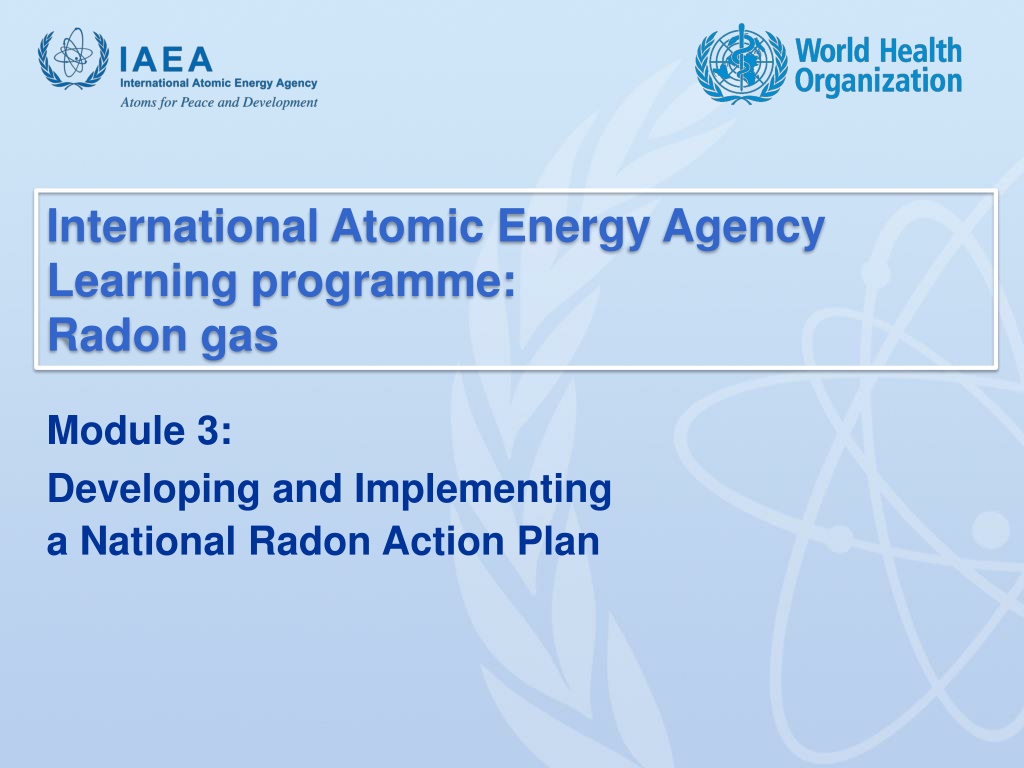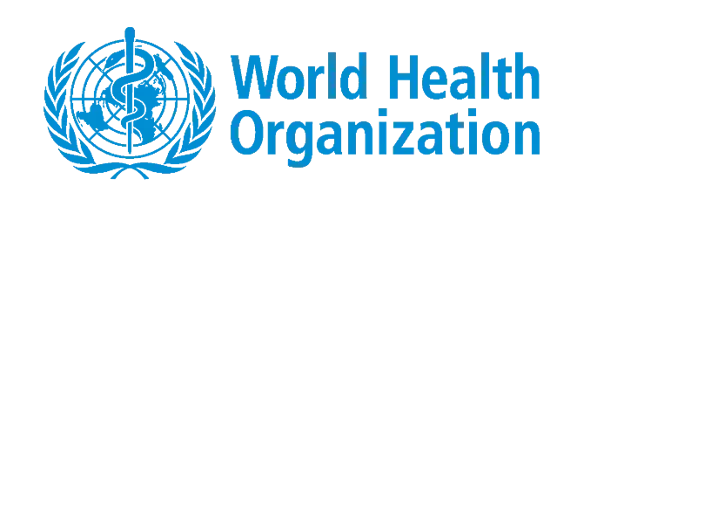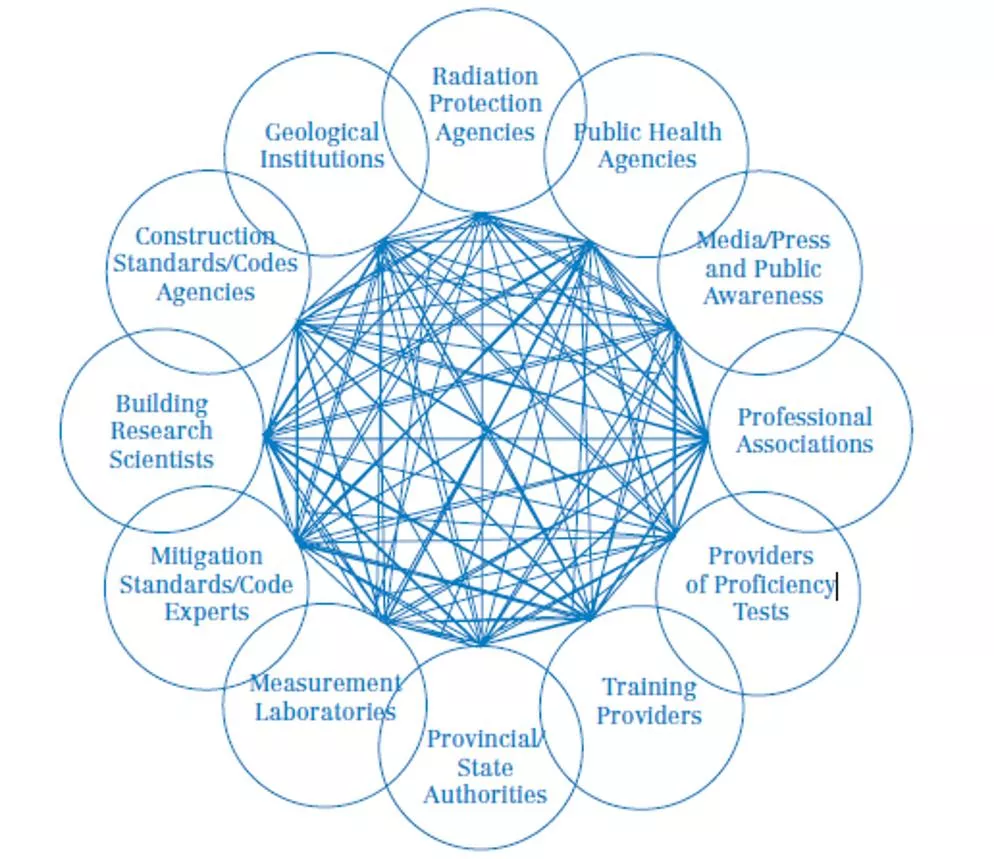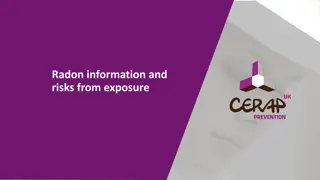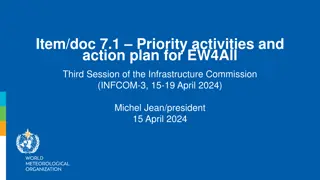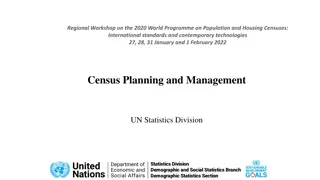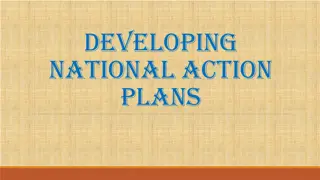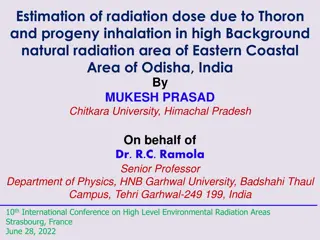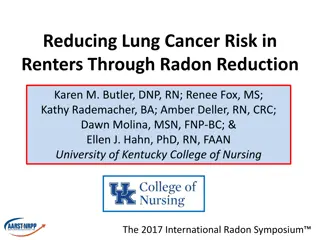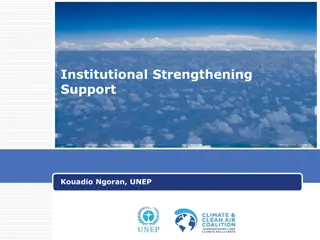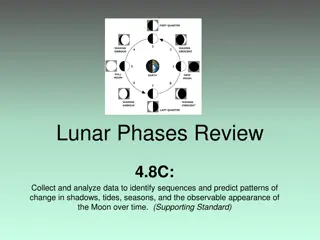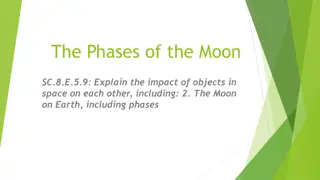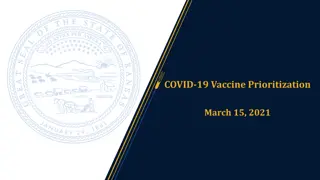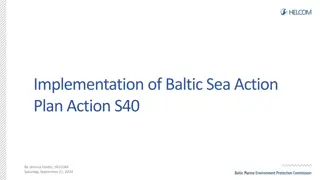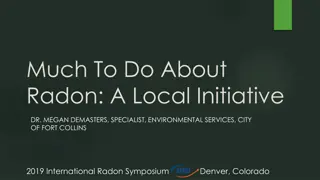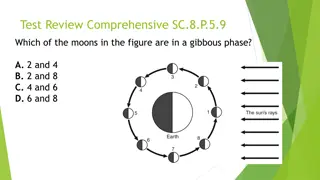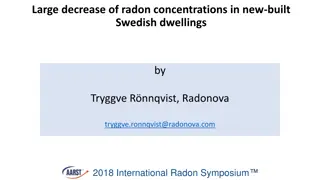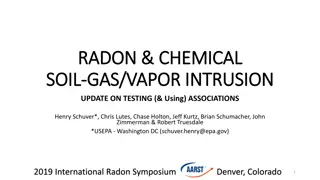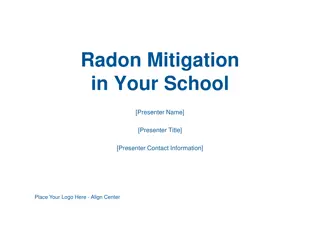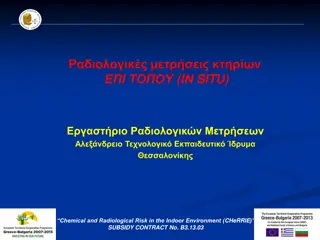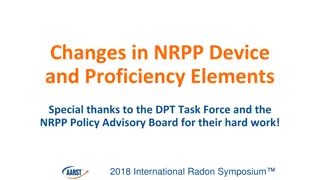Developing and Implementing a National Radon Action Plan: Key Phases and Considerations
This learning programme by the International Atomic Energy Agency focuses on the development and implementation of a National Radon Action Plan. It covers the typical elements, timelines, and phases involved in creating such a plan, emphasizing radon reduction, prevention, and synergies with real estate transactions. The plan's requirements, including government evaluation of exposure situations and coordinated actions for radon reduction, are highlighted. Stakeholder consultations, policy planning, implementation strategies, and monitoring metrics are key components in this comprehensive approach.
Download Presentation

Please find below an Image/Link to download the presentation.
The content on the website is provided AS IS for your information and personal use only. It may not be sold, licensed, or shared on other websites without obtaining consent from the author. Download presentation by click this link. If you encounter any issues during the download, it is possible that the publisher has removed the file from their server.
E N D
Presentation Transcript
International Atomic Energy Agency Learning programme: Radon gas Module 3: Developing and Implementing a National Radon Action Plan
Content Overview: National Radon Action Plan Typical timelines and phases Typical elements of a National Radon Action Plan Radon Reduction Radon Prevention Synergies Real Estate Transactions Awareness and Advocacy Metrics of success Summary of learning points Further reading 2
National Action Plan - Overview Requirement 47 of General Safety Requirements (GSR) Part 3 requires government to evaluate existing exposure situations Requirement 50 of GSR Part 3 requires that Where activity concentrations of radon that are of concern for public health are identified , the government shall ensure that an action plan is established comprising coordinated actions to reduce activity concentrations of radon in existing buildings and in future buildings Such an action plan should be implemented by the national authority 3
National Action Plan - Overview Multi-agency effort Government-backed Designated lead authority WHO 2009 4
National Action Plan Development Phases A multi-annual action plan Evaluation and Assessment Policy and Planning Implementation Reference level Technical standards Action areas Draft action plan Stakeholder consultations Planning and co- ordination Action delivery Research Communications Monitoring and metrics Report and review Available data Targeted radon surveys Radon map Risk assessment Existing legislation Resources 5
National Action Plan Development Phases A multi-annual action plan Evaluation and Assessment Policy and Planning Implementation Reference level Technical standards Action areas Draft action plan Stakeholder consultations Planning and co- ordination Action delivery Research Communications Monitoring and metrics Report and review Available data Targeted radon surveys Radon map Risk assessment Existing legislation Resources 6
National Action Plan Development Phases A multi-annual action plan Evaluation and Assessment Policy and Planning Implementation Reference level Technical standards Action areas Draft action plan Stakeholder consultations Planning and co- ordination Action delivery Research Communications Monitoring and metrics Report and review Available data Targeted radon surveys Radon map Risk assessment Existing legislation Resources 7
National Action Plan Development Phases A multi-annual action plan Evaluation and Assessment Policy and Planning Implementation Reference level Technical standards Action areas Draft action plan Stakeholder consultations Planning and co- ordination Action delivery Research Communications Monitoring and metrics Report and review Available data Targeted radon surveys Radon map Risk assessment Existing legislation Resources 8
National Action Plan Development Phases A multi-annual action plan Evaluation and Assessment Policy and Planning Implementation Reference level Technical standards Action areas Draft action plan Stakeholder consultations Planning and co- ordination Action delivery Research Communications Monitoring and metrics Report and review Available data Targeted radon surveys Radon map Risk assessment Existing legislation Resources 9
Exposure-to-Dose: the basis of the reference level Calculating radiation dose due to radon exposure takes account of: Radon concentration to which the person is exposed The ratio of radon to its progeny in the measured concentration (F-value) The duration of exposure The detriment caused by exposure (Exposure dose conversion factor) 10
Exposure-to-Dose: the basis of the reference level The F-value is variable with local conditions; United Nations Scientific Committee on the Effects of Atomic Radiation (UNSCEAR) recommends an F-value of 0.6 for radon outdoors and 0.4 for radon indoors The duration of exposure for homes is calculated on 7 000 hours or 80% of the year Exposure dose conversion factor which is equivalent to 6 millisieverts (mSv) per Working Level Month (WLM) o o o 1 WLM = (3 700Bq/ m3 x170h) / F-value o 1WLM = (3 700 170)/1.0 = 629 kBq/m3 h (at equilibrium, F-value of 1.0) 1WLM = (3 700 170)/0.6 = 1048 kBq/m3 h (assuming an F-value of 0.6) 1WLM = (3 700 170)/0.4 = 1573 kBq/m3 h (assuming an F-value of 0.4) Where an F-value of 0.4 is assumed for indoor exposure: 1 WLM is equivalent to 1 573 (rounded up to 1600) kBq/m3 h which is equivalent to 6mSv Therefore 1 mSv is equivalent to 267 kBq/m3 h (or 1 600/6) of radon exposure or 38 (rounded up to 40) Bq/m3 assuming a 7 000 hr annual exposure period o o o 11
Sustainable Action on Radon Regulation Routine Regulatory requirements to test and reduce radon concentrations in homes intended for rental, applicable to private and state landlords a housing authority, homes receiving government grants or tax incentives in relation to energy efficiency an energy efficiency authority, state residential institutions and workplaces the state asset management authority, buildings occupied by licensed activities with high - a licensing authority for such activities. Mandatory or voluntary requirements to check radon concentrations when homes are sold collaboration with the judicial services. Regulatory requirements to test and reduce radon concentrations in workplaces as part of health and safety requirements - health and safety authorities. Government funds available to support testing and remediation either through a dedicated fund or supplement to other (e.g. home improvement) funds. Where limited resources are available funding for remediation should be prioritised. 12
Elements of an Action Plan Radon reduction (existing buildings) Radon prevention (new buildings) Awareness and Advocacy Government Objective of Reducing Radon Exposure Behavioural Change Synergies Real estate transactons 13
Radon Mitigation (existing buildings) Radon Survey and mapping Radon prone areas or building types or all new buildings Remediation and Re-testing Radon measurement programme 14
Radon Mitigation (existing buildings) contd Radon Survey and mapping Radon prone areas or building types or all new buildings Remediation and Re-testing Radon measurement programme 15
Radon Prevention (new buildings) Radon Survey and mapping Building Standards Radon prone areas or building types or all new buildings 16
Synergies Energy Efficiency Anti- smoking Health and Safety 17
Real Estate Transactions In Europe every home sells on average every 21 years. Information on radon concentration could be requested as a part of the price estimate or made available for the potential buyer upon request 18
Awareness and Advocacy Communications Strategy Identify Critical Stakeholders and Partners Communicate Goals and Metrics Develop key messages for each stakeholder group Use appropriate media for each stakeholder group 19
Some key stakeholders Building Industry Public Builders, architects, etc Solicitors, insurers, etc Professional education establishments Rn measurement companies Rn remediation companies Householders Employers Employees/unions Landlords Researchers Governmental/State Geology Civil engineering Radiation protection Epidemiology Local authorities Health professionals Central government/agencies Regulatory body
Monitoring & reviewing: Metrics Conceptual spectrum of leading and lagging indicators 21
Summary Learning Points (1) Where radon concentrations present a public health concern a (National) Radon Action Plan (RAP) is a requirement of GSR Part 3. A RAP is typically a multi-agency multi-year programme, ideally with a designated lead authority assigned by the government to co-ordinate among many involved parties. The RAP starts with evaluation and assessment of the radon problem, followed by policy development and action planning, finally, leading to implementation. The responsible authority can decide the priority actions and whether they are mandatory or voluntary. 22
Summary Learning Points (2) Where the state funding is limited, it is recommended that radon remediation and prevention are given priority due to greater health benefit. There is potential to align action on radon with action on energy efficiency in buildings, anti-smoking campaigns, and workplace health and safety. Real estate transactions are a known driver of voluntary testing of private homes. A communications strategy is required to underpin the RAP. The RAP should be monitored and regularly reviewed for successful outcomes. 23
Further Reading International Atomic Energy Agency (IAEA) (2014). Radiation Protection and Safety of Radiation Sources: International Basic Safety Standards. General Safety Requirements Part 3. IAEA (2015). Protection of the Public against Exposure Indoors due to Radon and Other Natural Sources of Radiation. Specific Safety Guide. IAEA Safety Standards Series No. SSG-32. IAEA - A Flowchart for the Development of a National Radon Action Plan (RAP): https://www-ns.iaea.org/tech-areas/communication- networks/orpnet/documents/FINAL-radon.pdf World Health Organization (2009). Handbook on Radon: A Public Health Perspective, Geneva. Bochicchio et al., (2014). National Radon Programmes and Policies: The RADPAR Recommendations. Radiation Protection Dosimetry, pp. 1 4. IAEA/AQ/33: National and Regional Surveys of Radon Concentration in Dwellings: Review of Methodology and Measurement Techniques 24
